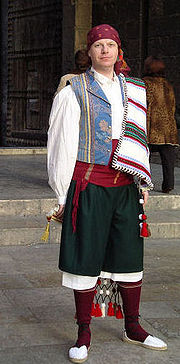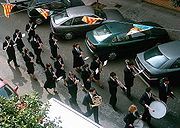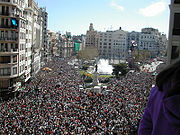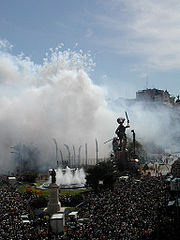
Falles
Encyclopedia

Grammatical number
In linguistics, grammatical number is a grammatical category of nouns, pronouns, and adjective and verb agreement that expresses count distinctions ....
Falla; ) is a Valencian traditional celebration in praise of Saint Joseph
Saint Joseph
Saint Joseph is a figure in the Gospels, the husband of the Virgin Mary and the earthly father of Jesus Christ ....
in Valencia, Spain
Spain
Spain , officially the Kingdom of Spain languages]] under the European Charter for Regional or Minority Languages. In each of these, Spain's official name is as follows:;;;;;;), is a country and member state of the European Union located in southwestern Europe on the Iberian Peninsula...
. The term Falles refers to both the celebration and the monuments created during the celebration. A number of towns in the Valencian Community
Valencian Community
The Valencian Community is an autonomous community of Spain located in central and south-eastern Iberian Peninsula. Its capital and largest city is Valencia...
have similar celebrations inspired in the original one from the city of Valencia.
Each neighbourhood of the city has an organized group of people, the Casal faller, that works all year long holding fundraising parties and dinners, usually featuring the famous specialty paella
Paella
Paella is a Valencian rice dish that originated in its modern form in the mid-19th century near lake Albufera, a lagoon in Valencia, on the east coast of Spain. Many non-Spaniards view paella as Spain's national dish, but most Spaniards consider it to be a regional Valencian dish...
. Each casal faller produces a construction known as a falla which is eventually burnt. A casal faller is also known as a comissió fallera.
The name of the festival is thus the plural of the Valencian
Catalan language
Catalan is a Romance language, the national and only official language of Andorra and a co-official language in the Spanish autonomous communities of Catalonia, the Balearic Islands and Valencian Community, where it is known as Valencian , as well as in the city of Alghero, on the Italian island...
word falla. The word's derivation is as follows:
- LatinLatinLatin is an Italic language originally spoken in Latium and Ancient Rome. It, along with most European languages, is a descendant of the ancient Proto-Indo-European language. Although it is considered a dead language, a number of scholars and members of the Christian clergy speak it fluently, and...
"torch" → LatinLatinLatin is an Italic language originally spoken in Latium and Ancient Rome. It, along with most European languages, is a descendant of the ancient Proto-Indo-European language. Although it is considered a dead language, a number of scholars and members of the Christian clergy speak it fluently, and...
(diminutive) → Vulgar LatinVulgar LatinVulgar Latin is any of the nonstandard forms of Latin from which the Romance languages developed. Because of its nonstandard nature, it had no official orthography. All written works used Classical Latin, with very few exceptions...
} → ValencianCatalan languageCatalan is a Romance language, the national and only official language of Andorra and a co-official language in the Spanish autonomous communities of Catalonia, the Balearic Islands and Valencian Community, where it is known as Valencian , as well as in the city of Alghero, on the Italian island...
falla.
Falles and ninots
Formerly, much time would also be spent at the Casal Faller preparing the ninots (ValencianValencian
Valencian is the traditional and official name of the Catalan language in the Valencian Community. There are dialectical differences from standard Catalan, and under the Valencian Statute of Autonomy, the Acadèmia Valenciana de la Llengua has been established as its regulator...
for puppets or dolls). During the week leading up to March 19, each group takes its ninot out for a grand parade, and then mounts it, each on its own elaborate firecracker
Firecracker
A firecracker is a small explosive device primarily designed to produce a large amount of noise, especially in the form of a loud bang; any visual effect is incidental to this goal. They have fuses, and are wrapped in a heavy paper casing to contain the explosive compound...
-filled cardboard
Paperboard
Paperboard is a thick paper based material. While there is no rigid differentiation between paper and paperboard, paperboard is generally thicker than paper. According to ISO standards, paperboard is a paper with a basis weight above 224 g/m2, but there are exceptions. Paperboard can be single...
and paper-mâché artistic monument in a street of the given neighbourhood. This whole assembly is a falla.
The ninots and their falles are developed according to an agreed upon theme that was, and continues to be a satirical jab at anything or anyone unlucky enough to draw the attention of the critical eyes of the fallers — the celebrants themselves. In modern times, the whole two week long festival has spawned a huge local industry, to the point that an entire suburban area has been designated the City of Falles — Ciutat fallera. Here, crews of artists and artisans, sculptors, painters, and many others all spend months producing elaborate constructions, richly absurd paper and wax, wood and styrofoam tableaux towering up to five stories, composed of fanciful figures in outrageous poses arranged in gravity-defying architecture, each produced at the direction of the many individual neighbourhood Casals faller who vie with each to attract the best artists, and then to create the most outrageous monument to their target. There are more than 500 different falles in Valencia, including those of other towns in the Valencian Community
Valencian Community
The Valencian Community is an autonomous community of Spain located in central and south-eastern Iberian Peninsula. Its capital and largest city is Valencia...
.
During Falles, many people from their casal faller dress in the regional and Valencia costumes from different eras of Valencia's history — the dolçaina
Dulzaina
The dulzaina or dolçaina is a Spanish double reed instrument in the oboe family. It has a conical shape and is the equivalent of the Breton bombarde....
and tabalet
Drum
The drum is a member of the percussion group of musical instruments, which is technically classified as the membranophones. Drums consist of at least one membrane, called a drumhead or drum skin, that is stretched over a shell and struck, either directly with the player's hands, or with a...
(a kind of Valencian drum) are frequently heard, as most of the different casals fallers have their own traditional bands.
Although the Falles are a very traditional event and many participants dress in medieval clothing, the ninots for 2005 included such modern characters as Shrek
Shrek
Shrek is a 2001 American computer-animated fantasy comedy film directed by Andrew Adamson and Vicky Jenson, featuring the voices of Mike Myers, Eddie Murphy, Cameron Diaz, and John Lithgow. Loosely based on William Steig's 1990 fairy tale picture book Shrek!...
and George W. Bush
George W. Bush
George Walker Bush is an American politician who served as the 43rd President of the United States, from 2001 to 2009. Before that, he was the 46th Governor of Texas, having served from 1995 to 2000....
.
Events During Falles


La Despertà
Each day of Falles begins at 5am with La Despertà ("the wake-up call"). Brass bands will appear from the casals and begin to march down every road playing lively music. Close behind them are the fallers throwing large firecrackers in the street as they go.

La Mascletà
The Mascletà, an explosive display of the concussive effects of coordinated firecracker and fireworksFireworks
Fireworks are a class of explosive pyrotechnic devices used for aesthetic and entertainment purposes. The most common use of a firework is as part of a fireworks display. A fireworks event is a display of the effects produced by firework devices...
barrages, takes place in each neighbourhood at 2 pm every day of the festival; the main event is the municipal Mascleta in the Plaça de l'Ajuntament where the pyrotechnicians compete for the honor of providing the final Mascleta of the fiestas (on March 19). At 2pm the clock chimes and the Fallera Mayor (dressed in her fallera finery) will call from the balcony of the City Hall
City hall
In local government, a city hall, town hall or a municipal building or civic centre, is the chief administrative building of a city...
, Senyor pirotècnic, pot començar la mascletà! ("Mr. Pyrotechnic, you may commence the Mascletà!"), and the Mascletà begins.
Mascletà is almost unique to the Valencian Community
Valencian Community
The Valencian Community is an autonomous community of Spain located in central and south-eastern Iberian Peninsula. Its capital and largest city is Valencia...
, hugely popular with the Valencian people and found in very few other places in the world. Smaller neighbourhoods often hold their own mascletà for saint's days, weddings and other celebrations.
La Plantà
The day of the 15th all of the falles infantils are to be finished being constructed and later that night all of the falles majors (major Falles) are to be completed. If not, they face disqualification.L'Ofrena floral
Each falla casal takes an offering of flowers to the virgin. This occurs all day on their days of March 17 and March 18. The virgin's body is then constructed with these flowers.Els Castells and La Nit del Foc
On the nights of the 15, 16, 17, and 18th there are firework displays in the old riverbed in Valencia. Each night is progressively grander and the last is called La Nit del Foc, the night of fire.La Cremà
On the final night of Falles, around midnight on March 19, these falles are burnt as huge bonfires. This is known as the cremà, i.e. "the burning", and this is of course the climax of the whole event, and the reason why the constructions are called falles ("torches"). Traditionally, the falla in the Plaça de l'Ajuntament is burned last.Many neighbourhoods have a falla infantil (a children's falla, smaller and without satirical themes), which is a few metres away from the main one. This is burnt first, at 10pm. The main neighbourhood falles are burnt closer to midnight. The awesome falles in the city centre often take longer. For example, in 2005, the fire brigade delayed the burning of the Egyptian funeral falla in Carrer del Convent de Jerusalem until 1.30am, when they were sure they had all safety concerns covered.
Each falla is adorned with fireworks which are lit first. The construction itself is lit either after or during these fireworks. Falles burn quite quickly, and the heat given off is felt by all around. The heat from the larger ones often drives the crowd back a couple of metres, even though they are already behind barriers that the fire brigade has set several metres away from the construction. In narrower streets, the heat scorches the surrounding buildings, and the firemen douse the façades, window blinds, street signs, etc. with their hoses in order to stop them catching fire or melting, from the beginning of the cremà until it cools down after several minutes.
Away from the falles, there are people going crazy through the streets, with the city resembling an open-air nightclub, except that instead of music there is the occasionally deafening sound of people throwing fireworks and bangers around randomly. There are stalls selling products such as the typical fried snacks porres, xurros and bunyols, as well as roast chestnuts or various trinkets.
History
There are a few different theories regarding the origin of the Falles festival. One theory suggests that the Falles started in the Middle AgesMiddle Ages
The Middle Ages is a periodization of European history from the 5th century to the 15th century. The Middle Ages follows the fall of the Western Roman Empire in 476 and precedes the Early Modern Era. It is the middle period of a three-period division of Western history: Classic, Medieval and Modern...
, when artisans put out their broken artifacts and pieces of wood that they sorted during the winter then burnt them to celebrate the spring equinox. Valencian carpenters used planks of wood to hang their candles on. These planks were known as parots. During the winter, these were needed to provide light for the carpenters to work by. With the coming of the Spring, they were no longer necessary, so they were burned. With time, and the intervention of the Church, the date of the burning of these parots was made to coincide with the celebration of the festival of Saint Joseph
Saint Joseph
Saint Joseph is a figure in the Gospels, the husband of the Virgin Mary and the earthly father of Jesus Christ ....
, the patron saint of the carpenters.
This tradition continued to change. The parot was given clothing so that it looked like a person. Features identifiable with some well-known person from the neighbourhood were added as well. To collect these materials, children went from house to house asking for Una estoreta velleta (An old rug) to add to the parot. This became a popular song that the children sang to gather all sorts of old flammable furniture and utensils to burn in the bonfire with the parot. These parots were the first ninots. With time, people of the neighbourhoods organized the process of the creation of the Falles and monuments including various figures were born.
Until the beginning of the twentieth century, the Falles were tall boxes with three or four wax dolls dressed in cloth clothing. This changed when the creators began to use cardboard. The creation of the Falle continues to evolve in modern day, when largest monuments are made of polystyrene
Polystyrene
Polystyrene ) also known as Thermocole, abbreviated following ISO Standard PS, is an aromatic polymer made from the monomer styrene, a liquid hydrocarbon that is manufactured from petroleum by the chemical industry...
and soft cork easily molded with hot saws. These techniques have allowed Falles to be created in excess of 30 meters.
Secció Especial
The Secció Especial is a group of the largest and most prestigious falles commissions in the city of Valencia. In 2007, the group consisted of 14 commissions. This class of falles was first started in 1942 and originally included the falles of Barques, Reina-Pau and Plaça del Mercat. Currently, none of these are still in the group. The commission that has most often participated in this group as of 2007 was Na Jordana, with 54 times. Winning the first prize in the Sección Especial is the most prestiguous prize any falla can win. All other falles fall into different classes that also award prizes with the exception of the one erected by the town hall.External links
- Official page for the Falles of ValenciaValencia (city in Spain)Valencia or València is the capital and most populous city of the autonomous community of Valencia and the third largest city in Spain, with a population of 809,267 in 2010. It is the 15th-most populous municipality in the European Union...
, SpainSpainSpain , officially the Kingdom of Spain languages]] under the European Charter for Regional or Minority Languages. In each of these, Spain's official name is as follows:;;;;;;), is a country and member state of the European Union located in southwestern Europe on the Iberian Peninsula... - Official page for the Falles of ValenciaValencia (city in Spain)Valencia or València is the capital and most populous city of the autonomous community of Valencia and the third largest city in Spain, with a population of 809,267 in 2010. It is the 15th-most populous municipality in the European Union...
, SpainSpainSpain , officially the Kingdom of Spain languages]] under the European Charter for Regional or Minority Languages. In each of these, Spain's official name is as follows:;;;;;;), is a country and member state of the European Union located in southwestern Europe on the Iberian Peninsula...
: http://www.fallasfromvalencia.com - Falles 2007 (in Spanish, Valencian, English, French and German): http://fallas.comunitatvalenciana.com
- Official history of Falles in English
- Gandia Les Falles Information in English
- Explanation of Falles acts in Spanish
- iPhone/iPod applcation about Las Fallas
- The Falles

